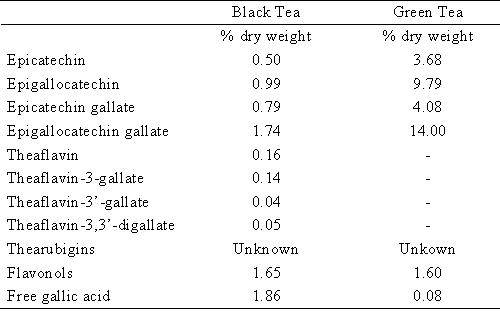Tea contains a number of polyphenols that have been shown to be beneficial in the prevention of cancer, cardiovascular disease, neurodegeneration, type II diabetes and weight gain. The major polyphenols in green tea are flavon-3-ols, but black tea also contains theaflavins and thearubigins (figure 1). The exact mechanism of absorption of tea polyphenols is not fully understood, but is known to be highly complex (figure 2). Tea polyphenols absorbed from the small intestine are extensively metabolised in the enterocytes to sulphated, glucuronidated or methylated conjugates by phase II enzymes such as sulfotransferase, glucuronosyltransferase and catechol-O-methyltransferase respectively. Some of these metabolites are absorbed from the enterocytes to the circulation where they pass to the liver. Further metabolism of polyphenols and their conjugates occurs in the liver before they pass to the kidney for excretion.
Figure 1. Polyphenol content of tea solids2. Theaflavin content of green tea not analysed but is typically negligible. Thearubigins could not be measured because of lack of a suitable analytical method. Flavonols analysed comprised of quercetin, kaempferol and myricetin.
Figure 2. Tea polyphenol absorption1
A large number of tea polyphenols are not absorbed from the small intestine because they are effluxed back to the gut lumen from enterocytes by apically located transporters, following conjugation. The endogenous microflora within the colon transform the remaining polyphenols and their conjugates to a number of different phenolic acids, via a fission of the central C3 ring. These phenolic acids are then absorbed from the colon, and pass to the liver where they are metabolised. Within the liver phenolic acids from black and green tea are though to be metabolised to hippuric acid and then excreted2. The urinary excretion of phenolic acids from tea exceeds that of intact parent flavonoids. Flavon-3-ols are detected in human prostate tissue and plasma after a ingestion, which suggests that some of the polyphenols may have biological effects in cells.
RdB


